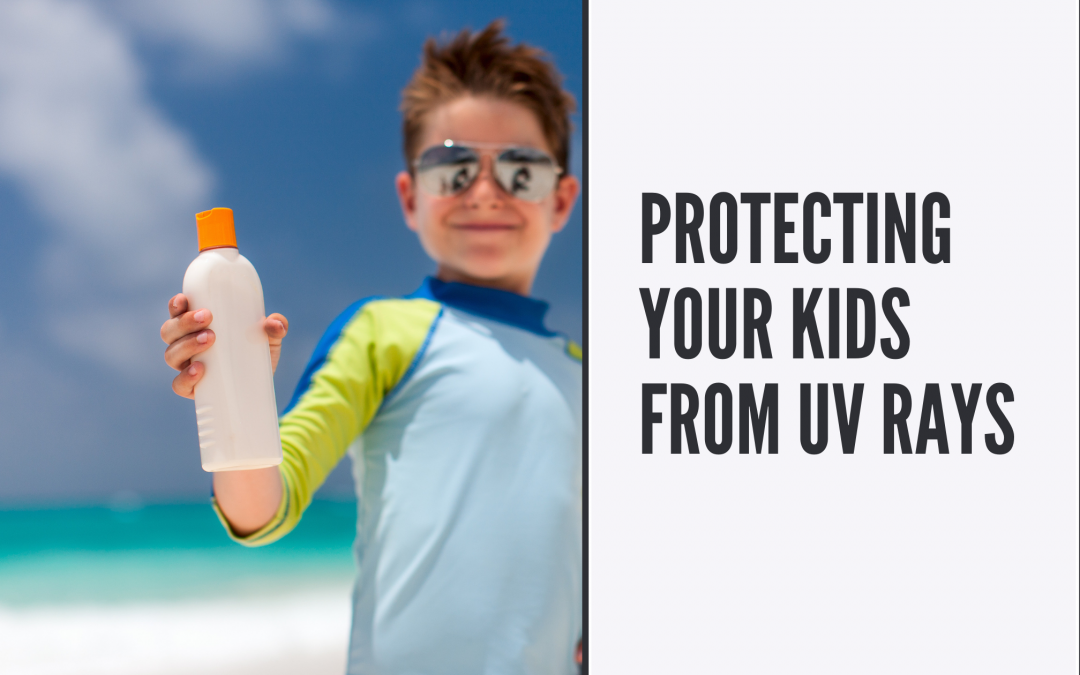Sun, sun, sun!!! Summer is here. Beaches. Pools. Backyard Bar-b-Ques. Has it been two years since we let the sun shine down upon us? Now we can go back out. That is a good thing. And a bad thing, especially for our kids when it comes to UV safety awareness.
You know, UV rays… those ultraviolet radiation emissions from the sun:
- UV-B rays have short wavelengths that reach the outer layer of your skin
- UV-A rays have longer wavelengths that can penetrate the middle layer of your skin
- Cause vision problems and damage to your eyes
- Suppress the immune system
- Responsible for premature aging of the skin
- Cause skin cancer
July is UV Safety Awareness Month!
Everyone should take safety steps dealing with over-exposure to the sun. Yet kids need to be extra careful. We don’t want to scare you, But there are A LOT of reasons.
Children’s immune systems are still developing. So, they are more likely to suffer from sun-related threats. We hope you will share this info with friends and family members during UV Safety Awareness Month.
Let’s start with a child’s skin. It is thinner and more sensitive than an adult’s skin. So even if a child spends a short time outdoors in the midday sun, that can result in serious burns.
Then, if you watch the short-term exposure time, there is still a concern for long-term exposure.
Estimates suggest that a person gets up to 80% of his/her lifetime exposure to UV rays before the age of 18.
Plus, studies show that frequent sun exposure and sunburn during childhood set the stage for high rates of melanoma later in life.
In other words, the harmful effects of the sun’s UV rays are not just an occasional sunburn incident. Children have more time to suffer. More time to develop diseases. More years of life for them to lose as a result of impaired health
What’s a Parent to Do?
Reducing UV rays exposure is the most effective way of protecting your children’s health
Always keep infants of less than 12 months in the shade.
Wear a Hat or some other shade-protective clothing. You want to partly shield the skin from the harmful effects of UV ray exposure.
Know when to go out!!! The sun is most intense at midday. Staying in the shade between the hours of 10 a.m. and 4 p.m. will further protect your skin.
Understand the UV Index. It forecasts the strength of UV rays each day. If the UV index is 3 or higher in your area, protect your skin from too much exposure to the sun.
Sunscreen is extremely important. But picking the right one and the proper amount of sunscreen are more important to avoiding the harmful effects of UV ray exposure.
The U.S. Food and Drug Administration has issued new regulations for sunscreen labeling. It recommends that your sunscreen have a sun protection factor (SPF) of at least 15. It should protect against both Ultraviolet A (UV-A) and Ultraviolet B (UV-B) rays.
The National Council on Skin Cancer Prevention says most people apply only 25-50 percent of the recommended amount of sunscreen. When out in the sun, you must apply at least one ounce (a palmful) of sunscreen every two hours. You should apply it more often if you are sweating or swimming, even if the sunscreen is waterproof.
Here is where parental controls need to come into effect. Kids won’t think of this, but you should. Sun protection is not only necessary on the beach or at the swimming pool but it also applies to all outdoor settings.
Children can be exposed to intense sunlight on the balcony at home, on weekend trips or a visit to the zoo, during breaks at kindergarten or school, and during outdoor sporting activities.
Children love playing outdoors. They usually are not aware of the harmful effects of UV radiation. Parents should serve as role models when it comes to UV safety awareness. It is their responsibility to provide more than adequate protection to their children.
If you wish to check the UV Index in your area:
The EPA provides info based on your submitting a zip code or city/state info: https://www.epa.gov/enviro/uv-index-search
North Carolina has a HomeFacts page with North Carolina UV Index Report: https://www.homefacts.com/uvindex/North-Carolina.html
This post was written by Anthony M Scialis. Find him here.

